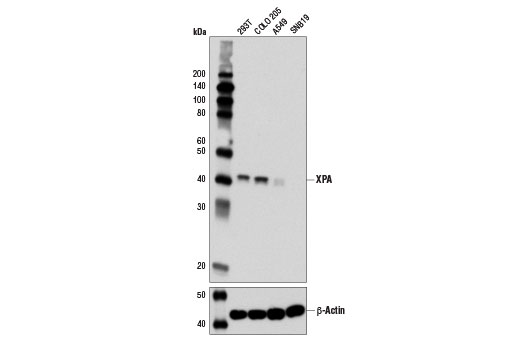WB
H
Endogenous
40
Rabbit IgG
#P23025
7507
Product Information
Product Usage Information
| Application | Dilution |
|---|---|
| Western Blotting | 1:1000 |
Storage
Specificity / Sensitivity
Species Reactivity:
Human
Source / Purification
Monoclonal antibody is produced by immunizing animals with a synthetic peptide corresponding to residues surrounding Arg158 of human XPA protein.
Background
Nucleotide excision repair (NER) is a process by which cells identify and repair DNA lesions that result from chemical and radiation exposure (1). The DNA binding protein XPA is an essential part of a pre-incision complex that forms at sites of damage, and is necessary for the initiation of nucleotide excision repair (2). XPA is one of eight NER proteins (XPA-G, XPV) encoded by genes that are defective in cases of xeroderma pigmentosum, a disorder characterized by sensitivity to sunlight, predisposition to exposed tissue cancers, and neurological defects in some patients (3). Activation of XPA follows phosphorylation at Ser196 and results in increased NER activity. Phosphorylation of XPA at Ser196 is induced by UV exposure in an ATR-dependant fashion (4) and promotes nuclear accumulation of XPA (5). Research studies suggest that XPA may be a direct substrate of the serine/threonine kinase ATR (4) and that NER activity may be negatively regulated through dephosphorylation of Ser196 by the phosphatase WIP1 (6).
- Fuss, J.O. and Cooper, P.K. (2006) PLoS Biol 4, e203.
- Missura, M. et al. (2001) EMBO J 20, 3554-64.
- DiGiovanna, J.J. and Kraemer, K.H. (2012) J Invest Dermatol 132, 785-96.
- Wu, X. et al. (2006) Cancer Res 66, 2997-3005.
- Wu, X. et al. (2007) Oncogene 26, 757-64.
- Nguyen, T.A. et al. (2010) DNA Repair (Amst) 9, 813-23.
Species Reactivity
Species reactivity is determined by testing in at least one approved application (e.g., western blot).
Western Blot Buffer
IMPORTANT: For western blots, incubate membrane with diluted primary antibody in 5% w/v nonfat dry milk, 1X TBS, 0.1% Tween® 20 at 4°C with gentle shaking, overnight.
Applications Key
WB: Western Blotting
Cross-Reactivity Key
H: human M: mouse R: rat Hm: hamster Mk: monkey Vir: virus Mi: mink C: chicken Dm: D. melanogaster X: Xenopus Z: zebrafish B: bovine Dg: dog Pg: pig Sc: S. cerevisiae Ce: C. elegans Hr: horse GP: Guinea Pig Rab: rabbit All: all species expected
Trademarks and Patents
Limited Uses
Except as otherwise expressly agreed in a writing signed by a legally authorized representative of CST, the following terms apply to Products provided by CST, its affiliates or its distributors. Any Customer's terms and conditions that are in addition to, or different from, those contained herein, unless separately accepted in writing by a legally authorized representative of CST, are rejected and are of no force or effect.
Products are labeled with For Research Use Only or a similar labeling statement and have not been approved, cleared, or licensed by the FDA or other regulatory foreign or domestic entity, for any purpose. Customer shall not use any Product for any diagnostic or therapeutic purpose, or otherwise in any manner that conflicts with its labeling statement. Products sold or licensed by CST are provided for Customer as the end-user and solely for research and development uses. Any use of Product for diagnostic, prophylactic or therapeutic purposes, or any purchase of Product for resale (alone or as a component) or other commercial purpose, requires a separate license from CST. Customer shall (a) not sell, license, loan, donate or otherwise transfer or make available any Product to any third party, whether alone or in combination with other materials, or use the Products to manufacture any commercial products, (b) not copy, modify, reverse engineer, decompile, disassemble or otherwise attempt to discover the underlying structure or technology of the Products, or use the Products for the purpose of developing any products or services that would compete with CST products or services, (c) not alter or remove from the Products any trademarks, trade names, logos, patent or copyright notices or markings, (d) use the Products solely in accordance with CST Product Terms of Sale and any applicable documentation, and (e) comply with any license, terms of service or similar agreement with respect to any third party products or services used by Customer in connection with the Products.
